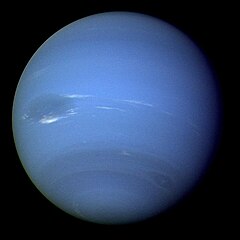Neptunus

Neptunus dari wahana Voyager 2
Neptunus merupakan planet terjauh (kedelapan) jika ditinjau dari Matahari.Neptunus memiliki jarak rata-rata dengan Matahari sebesar 4.450 juta km. Neptunus memiliki diameter mencapai 49.530 km dan memiliki massa 17,2 massa Bumi. Periode rotasi planet ini adalah 16,1 jam., sedangkan periode revolusi adalah 164,8 tahun. Bentuk planet ini mirip dengan Bulan dengan permukaan terdapat lapisan tipis silikat. Komposisi penyusun planet ini adalah besi dan unsur berat lainnya. Planet Neptunus memiliki 8 buah satelit, di antaranya Triton, Proteus, Nereid, dan Larissa.
[sunting] Rujukan
- ^ Hamilton, Calvin J. (August 4, 2001). "Neptune". Views of the Solar System. http://www.solarviews.com/eng/neptune.htm. Diakses pada 13 Agustus 2007.
- ^ Yeomans, Donald K. (July 13, 2006). "HORIZONS System". NASA JPL. http://ssd.jpl.nasa.gov/?horizons. Diakses pada 8 Agustus 2007.—At the site, go to the "web interface" then select "Ephemeris Type: ELEMENTS", "Target Body: Neptune Barycenter" and "Center: Sun".
- ^ Orbital elements refer to the barycentre of the Neptune system, and are the instantaneous osculating values at the precise J2000 epoch. Barycentre quantities are given because, in contrast to the planetary centre, they do not experience appreciable changes on a day-to-day basis from to the motion of the moons.
- ^ a b c d e f g h i j k l m n o Williams, David R. (September 1, 2004). "Neptune Fact Sheet". NASA. http://nssdc.gsfc.nasa.gov/planetary/factsheet/neptunefact.html. Diakses pada 14 Agustus 2007.
- ^ "The MeanPlane (Invariable plane) of the Solar System passing through the barycenter". 3 April 2009. http://home.comcast.net/~kpheider/MeanPlane.gif. Diakses pada 10 April 2009. (produced with Solex 10 written by Aldo Vitagliano; see also Invariable plane)
- ^ a b c d P. Kenneth, Seidelmann (2007). "Report of the IAU/IAGWorking Group on cartographic coordinates and rotational elements". Celestial Mechanics and Dynamical Astronomy (Springer Netherlands) 90: 155–180. doi:. http://adsabs.harvard.edu/doi/10.1007/s10569-007-9072-y. Diakses pada 7 Maret 2008.
- ^ a b c d e f g Refers to the level of 1 bar (100 kPa) atmospheric pressure
Tidak ada komentar:
Posting Komentar